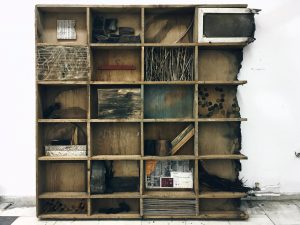My own identity crucially depends on
my dialogical relations with others.
-Taylor
I am seeing myself in the eyes of the Other. With comparing my similarities and differences between “I” and “You” I can write about my identity. I am different from You and, in the same time, similar to You. I’m seeing the things what I have or I don’t have through You. So, every identity depends on the other’s identity. It is impossible to separate only one “clear” identity for itself. My words are the words of the others. How they showed me. Or how they seas me. And at the same time, how I see them.
Identity is flowing everywhere at the same time.
Identity doesn’t have borders.
Identity is multilayered.
All these layers of identity are written and remembered in the objects around me. My memory is “printed” on every object I am using. Objects are keepers of the memory which is written by mine subjective identity.

* I am writing from the ‘subjective identity’ point of view. I’m using the first person, singular because I can’t speak in the name of the others.

There is an interesting dialogue between what you say about identity and its dependence on the other, and Ashok’s feeling of inevitable alienation in both the worlds that he has grown up in – the west and in India alike. I love how you talk of identity of ‘I’ as dependent on the other, in accordance with cultural alienation that so many feel because they have more than one ‘you’ or ‘other’ depending on their past and present. I am curious to draw a parallel, because possibly, as and when what we are dependent on changes or oscillates, our own identity becomes just as dynamic and oscillatory.
Your above lines –
“Identity is flowing everywhere at the same time.
Identity doesn’t have borders.
Identity is multilayered.”
I find it to be a poetic expression juxtaposed with the image you have used.
It compels me to question and know more about the image, since it is so intriguing; specially the broken edge which somewhere coexists with the broken/fragmented identity formed and buried under so many layers, which you are talking about here. Can you please tell me more about the image, the objects in the shelves and the deconstructed edge within the grid?
This installation is made out of old materials I found in the depo of the Cultural Centar in my born city-Prilep. I used this old objects who are full with memory inside them to re-tell their story/identity.
Some of the shelves are empty, some half full, some of them even closed. Every shelve is a story for its own, but still, when you see them all together, they are one piece. Every piece has a different identity, and, at the same time, collectively they are creating one mutual identity.
But, sure, this installation is not narrative and it’s open for a different kind of readings.
I think the installation has a very nostalgic feel which is accentuated by the broken edge, which makes the nostalgia very penetrating. Here, I would relate it to one of my works about memory which was done this year during a residency in Bhubaneswar, India. I had collected memories embodied in found objects from the coastal line of Mumbai and left those same objects/memories at the coastal line of Konark which is near Bhubaneswar, and at different places in the city. In exchange I collected the memory of the object’s departure through different mediums like sound, videos, impressions of the place, writings, objects etc which embark another memory. The photograph of the object left was displayed with the media gathered in exchange. you can see a few videos here:
https://vimeo.com/228869507
https://vimeo.com/229003472
There were a total of 10 exchanges and the work is called ‘Lost and Found Memories’. It is very similar to your installation though done in a different form and different process to capture memories. It is really interesting to see how ideas travel and interlink us. Building bridges through ideas.
Your interpretation of these old objects founded in forgotten depo in small city Prilep, it’s so correct. And that’s really interesting how we can “read” the memories of objects that are far from us and we don’t know anything about their past… It’s just fascinating how these stories are crossing all borders around us.
I checked almost all your videos, and I found inspiring how you combine objects, sounds, words, and video. Especially ‘Lost and Found Memories’ works. It’s like trying to find their old (or new) “Home” trough water or sounds… it’s so poetic!
The quote you use at the top of your post, by Charles Taylor, a philosopher I deeply admire, makes me realise that often our search for “our own, true identity” is guided by thinking of identity in static, private terms, in our own, individual history, our roots, the influences in our life, etc. Thinking of identity in relational terms, as something that develops in relation to others, changes the perspective and it is enlightening.